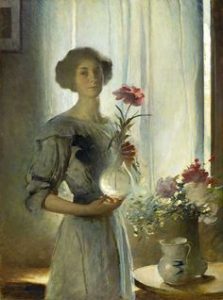hn White Alexander (1856-1915), an iconic figure in the realm of American art, made his indelible mark during the Victorian era. Alexander’s rise to prominence and his contribution to the art world during a transformative time in American history warrant a closer look.
Early Life and Training
Born in Allegheny, Pennsylvania, Alexander’s path to the arts was neither linear nor easy. Orphaned at a young age, he found work in the offices of a local telegraph company. By age 18, his innate artistic talent secured him a job illustrating for Harper’s Weekly, a prominent New York magazine. It was in New York that he came under the influence of illustrious illustrators and painters, including Thomas Moran and James Carroll Beckwith.
Realizing the potential in him, Alexander went to Europe for formal training. He studied in Munich under the guidance of Frank Duveneck and then proceeded to Paris to join the studio of renowned French painter Jean-Léon Gérôme.
Artistic Style and Legacy
Alexander is often lauded for his graceful portrayal of the human figure, especially women. His artistic style seamlessly merged the techniques of the Old World with the emerging American style. His portraits often evoke an ethereal quality, making use of elongated forms and fluid drapery. His works have a dreamlike quality, and he beautifully captured the delicate nuances of light and shadow.
In his paintings, one can observe the elegance and romanticism characteristic of the Victorian era, but with a fresh, modern approach. While many artists of his time were still heavily influenced by European aesthetics, Alexander’s works reflect a unique fusion, introducing a distinctly American flavour to traditional European styles.
“Isabella and the Pot of Basil” (1897) is one such piece where Alexander’s impeccable skill shines through. The artwork, which portrays a woman embracing a large pot containing a basil plant, is not just a visual treat, but also an emotional narrative, capturing pain, passion, and ethereal beauty in one frame.
Contribution to American Art
Apart from his individual works, Alexander played a pivotal role in the art scene of America. He was a founding member of the Ten American Painters, an influential group that sought to promote American art at a time when European art held considerable sway in the United States. Additionally, his involvement with organizations like the National Academy of Design and the Art Students League of New York solidified his position as a key figure in shaping the future of American art.
Later Life and Legacy
Alexander returned to the U.S in the late 1890s, where he continued to create and exhibit his works. In 1901, he was awarded the Legion of Honor by the French government. John White Alexander passed away in 1915, but he left behind an enviable body of work that continues to inspire artists and art enthusiasts around the world.
In retrospect, John White Alexander was more than just a talented painter. He was a bridge between two worlds – the established European art scene and the burgeoning American one. Through his works, teachings, and contributions, Alexander ensured that American art carved its own identity, independent and yet respectful of its European roots.

He worked as a telegraphic messenger initially and joined Harper’s Weekly as a political cartoonist and illustrator. He was assigned to create the drawings of on location work and this was used to make wood engravings.
He travelled in Europe with William Merritt Chase and Frank Duveneck spending time mostly in Munich and attended the Royal Academy.

He became familiar with the Tonalist style of painting when he was in Venice along with James McNeill Whistler. He got back to New York in 1881 and earned success in portraiture.
From 1890 to 1901, Alexander lived in Paris with his wife. Here they had cultivated a huge social circle that included Oscar Wilde, James Whistler, August Rodin, Henry James, and Andre Gide, to name a few.

This was the time when Alexander developed his signature style which can be seen in his well-known painting, An Interesting Book. His imaginative and powerful works included portraits and elongated paintings of females in a dim light background.
John Alexander artist had vital and direct involvement with several international art organizations and exhibitions can be seen by his participation in annual Paris salons along with the International Society of Sculptors, Painters, and Gravers, London.

He won Gold Medal in the 1900 Paris Universal Exposition and he was named Chevalier of the Legion of Honour in 1901. He was a member of the American Academy of Arts and Letters as well.
Finally, in 1901, John White Alexander settled in New York with his wife. Here he painted portraits of scores of people and became famous as the portrait painter.

The model who posed for ‘An Interesting book’ was one of the most adored models of the time, Evelyn Nesbit.
John White’s Paintings
The sophisticated, airy quality is depicted in the paintings of John Alexander artist. Both, the technique and style of Alexander depict his experiments with certain effects.
Alexander’s works were found in public and private collections. He involved completely in the development and promotion of American art.

This helped him become a member of the National Academy of Design in 1902. Eventually, he became the President of the National Academy from 1909 and continued till a short time before his death in 1915.
Who is John White in Current Times?
John White, of the present time, is a television and commercial actor, who worked in a Canadian film. He was born in 1980. He lives and works in Los Angeles, California.